The Víkingr exhibition is showing some of the most exquisite objects that we have from the Norwegian Viking Age. This includes the Gjermundbu helmet, which is the best preserved Viking helmet in the world. I spent some hours at this exhibit, and I’m impressed by how it tells the story of the Viking wars, journeys and culture. You find artifacts showing different aspects of life, death and society.
Visit to a Viking Museum in Oslo
The exhibition design was made by the Norwegian architecture firmSnøhetta, who also designed theOpera House in Oslo.It’s a pretty minimalist exhibition with 19 custom made tall glass vitrines, and there are good information folders available at the entrance where you can read about all the different “Viking treasures”.

I’ve taken some photos of the exhibition, and I present them to you here with descriptions of the various artifacts. I hope you’ll enjoy it! If you are interested in more Viking history, also check out my article aboutThe Viking Ships in Oslo.
Check out thisViking Exhibitionin person at the文化历史博物馆in Oslo.


You might also like:Did you know that you speak Viking?
1. The Silver Route – From Bagdad to Teisen
This silver hoard from the 900s was found in 1844 at Teisen Farm in Oslo. It consists of seven silver arm rings, pieces of hack-silver and Arabian and Persian coins from areas now in Iraq and Iran. The arm rings were probably made of silver that was melted down from coins like these. Hacked-up bits of silver ingots, jewellery and coins were used as means of payment in the time before coins were minted in Norway. The Vikings who engaged in international trade eastward were paid with silver coins, and large amounts of silver arrived in Scandinavia.
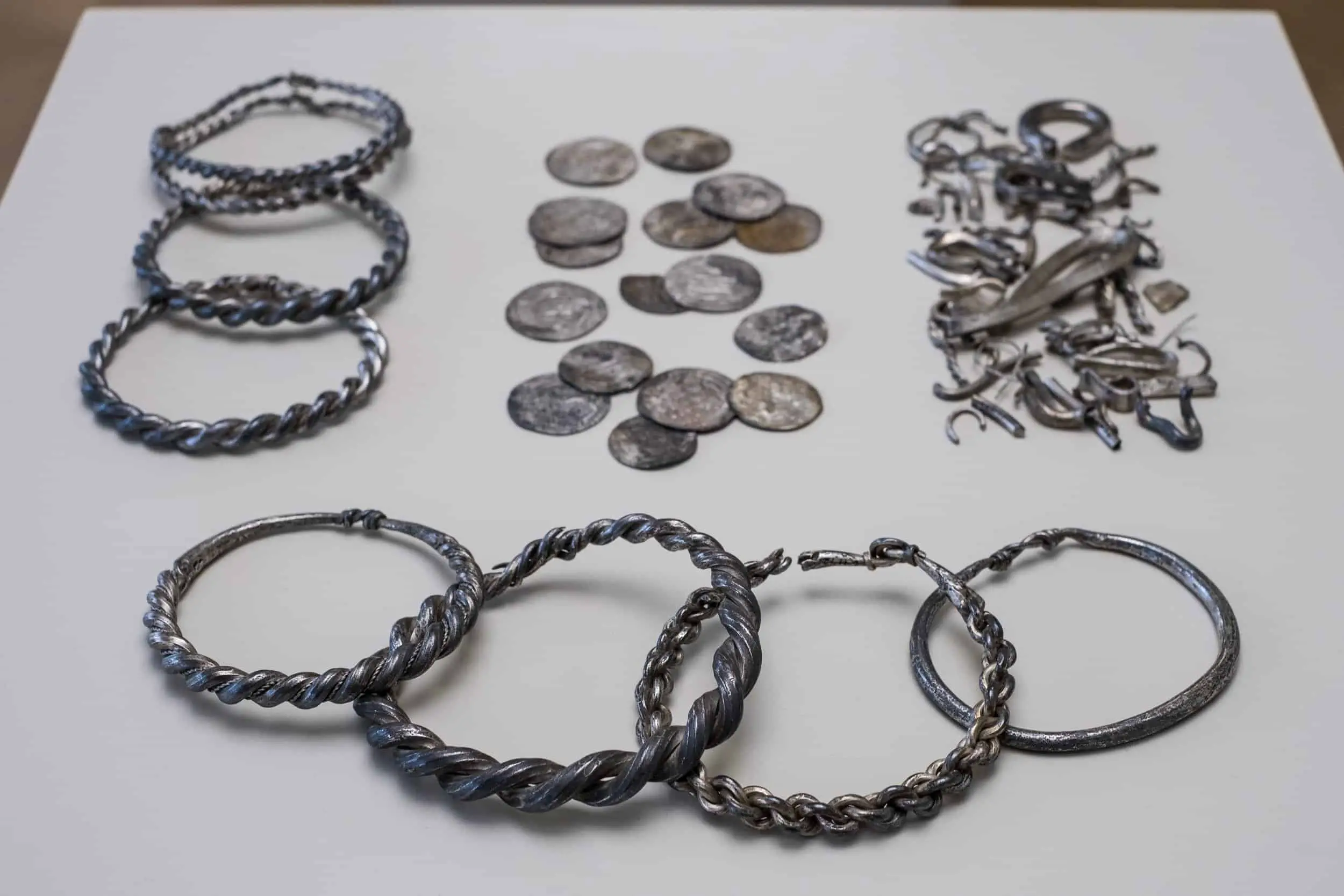 Silver hoard from the 900s
Silver hoard from the 900s
2. The Viking World in a Single Treasure
In the summer of 1834, a tenant farmer was working on Nedre Hon Farm in Øvre Eiker, Buskerud. He was digging drainage ditches when he suddenly unearthed Norway’s largest gold hoard from the Viking Age. The Hon Hoard is a unique collection of treasures: large gold rings, Frankish gold jewellery, Arabian coins, colourful beads, a Roman gemstone, and an English ring. The hoard is a reflection of Viking journeys and contacts, from the Caliphate in the east to England in the west.






3. Treasures from Charlemagne’s Empire
Several gold objects from the Hon Hoard were made in the Carolingian Empire in about 800. This large gold brooch originally adorned a warrior’s sword belt, or bandolier. Its shape and exquisite craftsmanship indicate that it was once used at the Carolinian court. It was later made into a brooch in Norway.


4. Long-distance Luxury
These pieces were made in the British Isles in the 700s. Many were originally used as decorative mounts on sacred objects used in churches, for instance on books and reliquaries. In Scandinavia, these types of objects are usually found in women’s graves and have been refashioned into brooches. They are evidence of the early Viking raids. When the Scandinavian Vikings first arrived in the British Isles, they attacked churches and monasteries. These places were often undefended and were easy to overwhelm.
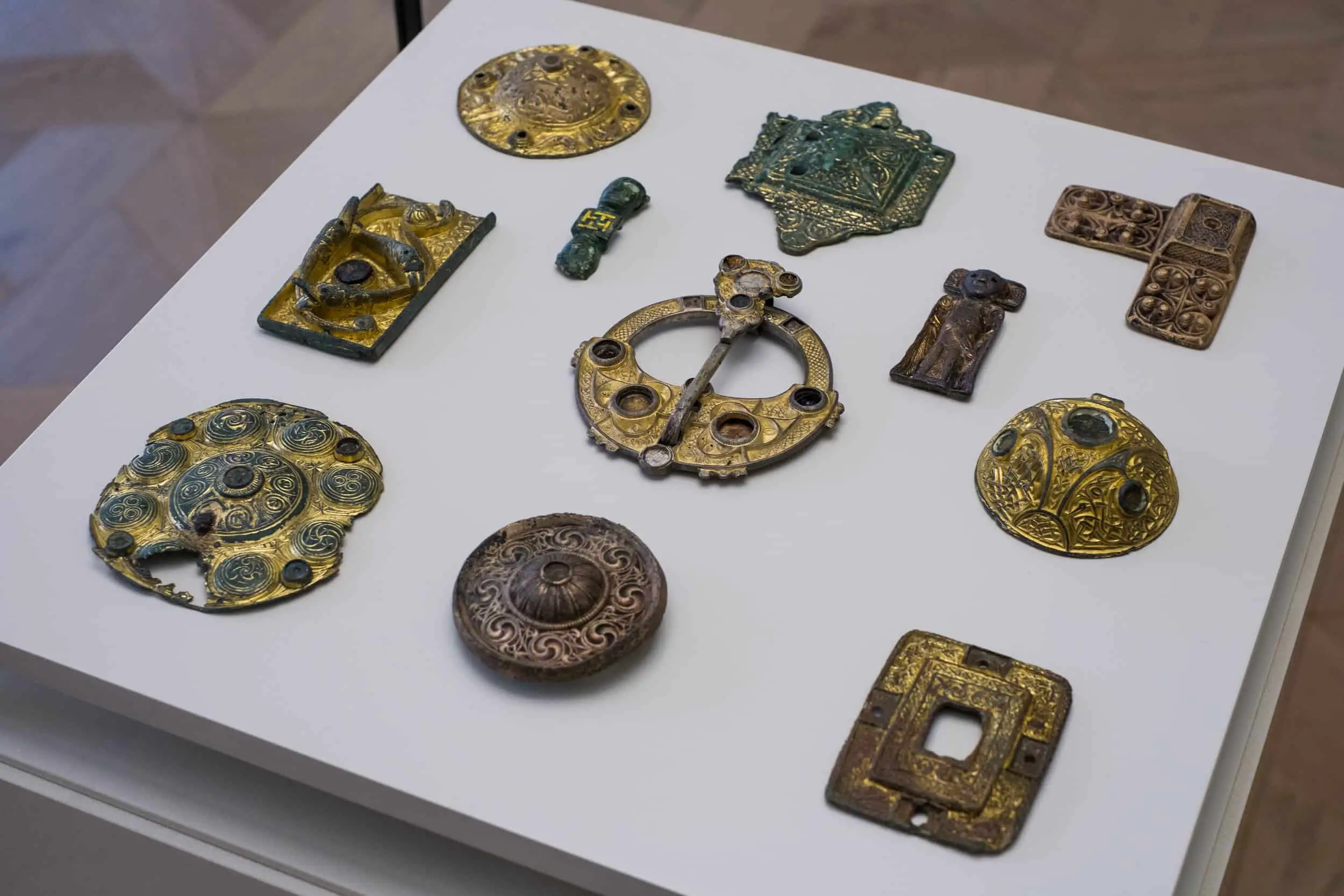
Viking war booty from Britain
5.椭圆形胸针——典型的斯堪的纳维亚
Oval brooches are the most common type of brooch from the Viking Age and are often found in pairs. They were used to fasten the straps on a woman’s suspended dress (dress with shoulder straps), with one on each side, just below the shoulders. This is the best-known dress for Scandinavian women in the Viking Age. The brooches are found throughout Scandinavia and also in areas where Scandinavians settled, from Russia in the east to England in the west. Ornamentation styles changed over time and reflect trends in jewellery design.
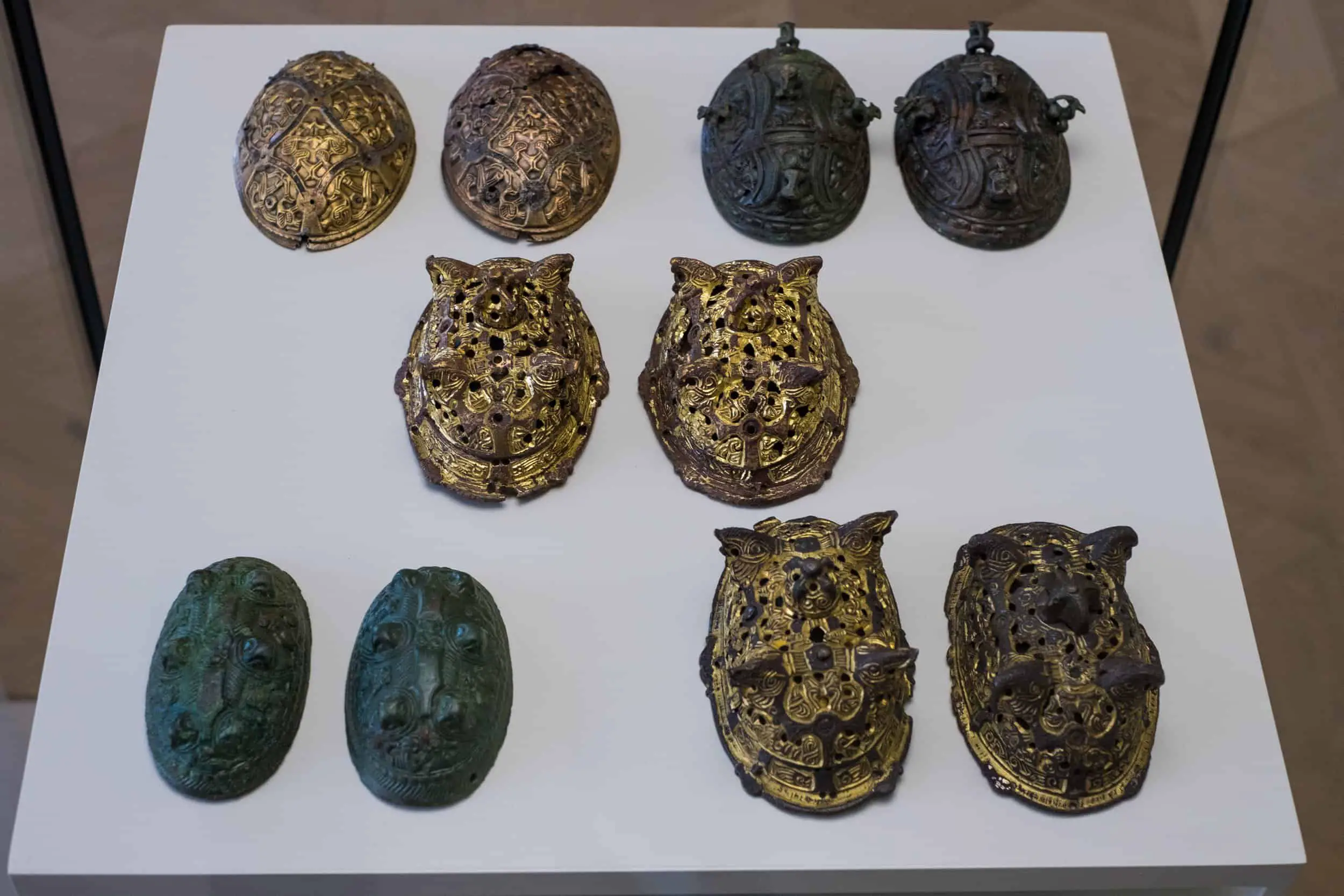
Imagine how decorative they must have been!
6. From Sword Belt to Brooch
Brooches with a characteristic triangular shape are called trefoil brooches. They were worn by women on the front of their clothing. Trefoil brooches reveal how Scandinavian craftsmen absorbed foreign impulses and incorporated them into their own visual language. Scandinavian trefoil brooches were modelled on Frankish sword-belt mounts from the 800s. In pictures of Charlemagne’s court, we see that the king’s warriors had threearmed mounts on their weapon belts. An elaborate example in gold was part of the Hon Hoard (see case no. 2). The ornamentation on the brooches developed from Frankishinspired geometrical designs to a pure Scandinavian animal-art style.
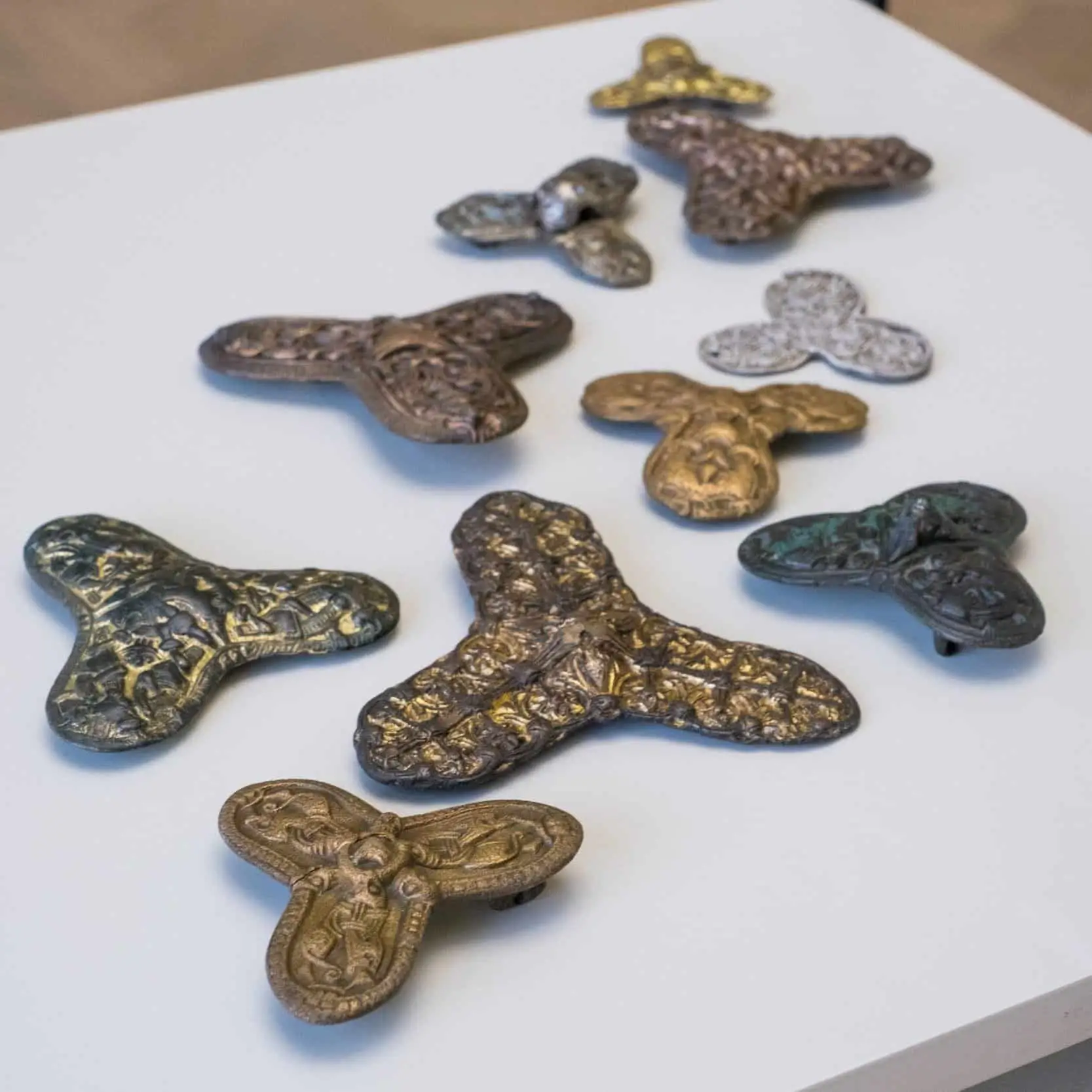
Trefoil brooches
You might also like:I Visit the Viking Ship Museum in Oslo
7. An Exceptional Spur
This gold spur was found in 1887 on Rød farm, during ploughing, along with a strap mount from the same spur. 30 years later a second mount was found in the same field. There were no traces of a grave or a second spur. Spurs are fastened to boots with leather straps and used to control a horse while riding. The gold spur is the only one of its kind from Viking-Age Scandinavia. Its intricate ornamentation is made of gold filigree and soldiered granules and depicts animals and patterns in the Borre style. It was probably made by a Scandinavian goldsmith in the latter half of the 900s.
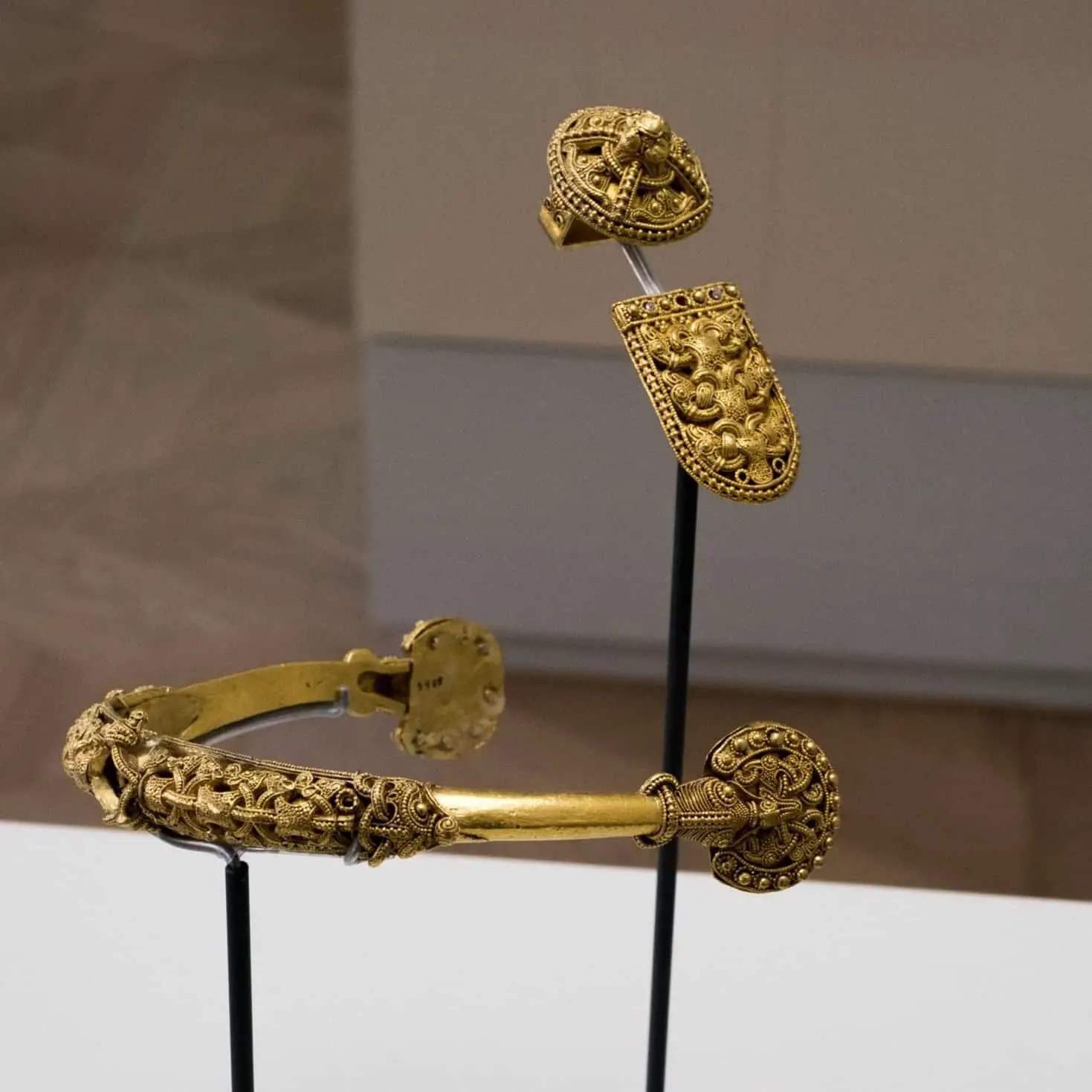
Have you ever seen a more luxurious spur?
8. The Gjermundbu Helmet
This helmet from Gjermundbu Farm is the best-preserved Viking helmet in the world. It was found in a well-furnished man’s grave that also contained a chain-mail shirt (Showcase 9), a sword, two spears, two axes, a shield, riding gear, gaming pieces and equipment for making food. The man who was buried had belonged to an elite group of equestrian warriors. The helmet was deliberately destroyed in connection with the funeral – it was pierced with the spears that lay in the grave – one stab from each.



9. Chainmail from Gjermundbu
This chainmail comes from the same grave as the Viking helmet (Showcase 8). It was found in many small pieces and only some fragments are displayed here. About 25,000 metal rings survive. This corresponds to the better part of the original shirt, which would have weighed between 8 and 10 kg. The process of making chainmail was time-consuming and could take up to half a year. One chainmail shirt cost as much as a shield, spear, sword and helmet combined. This type of armour was reserved for professional warriors and other elites in the Viking Age.
Advertisements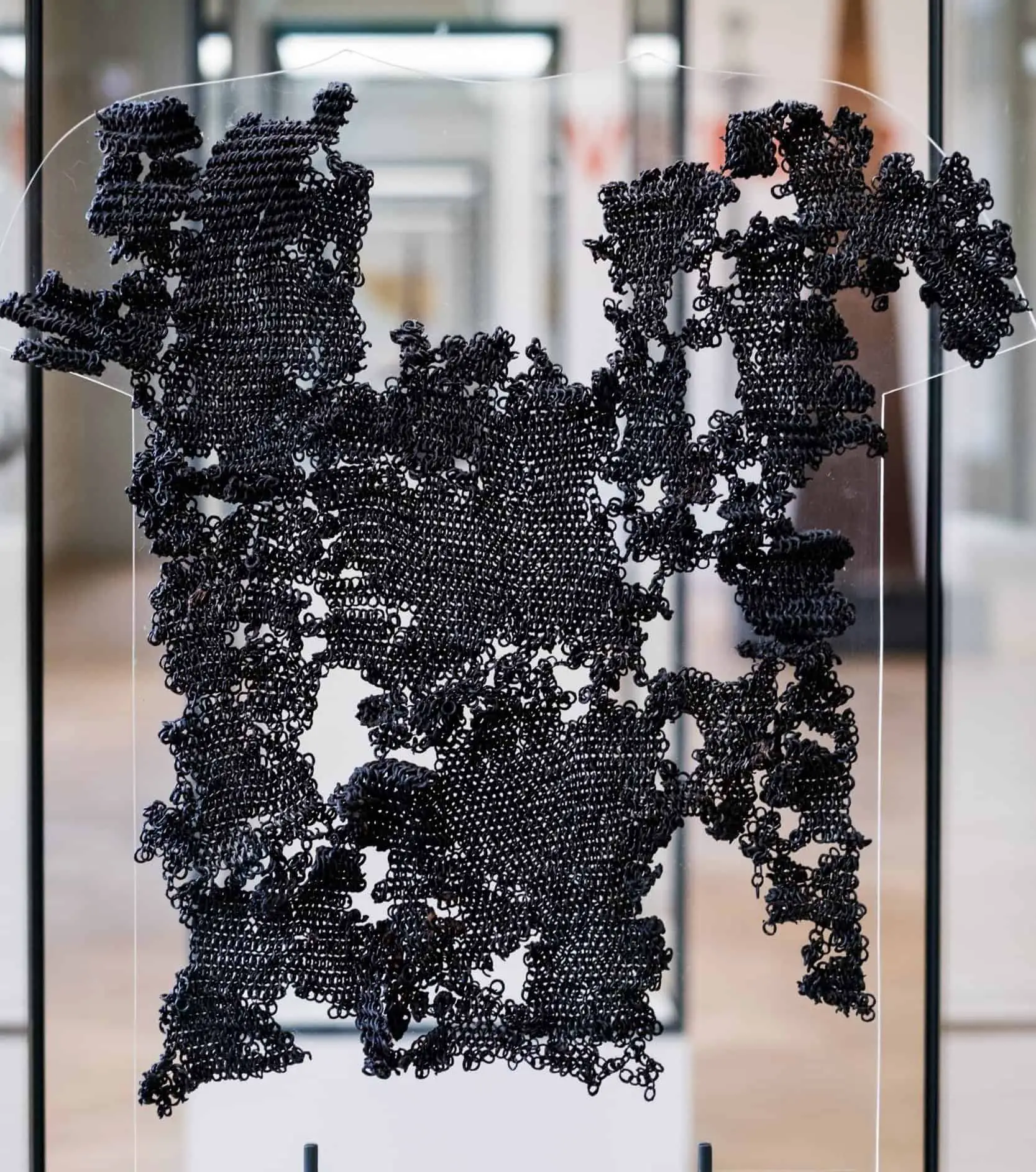
Viking Chainmail (Brynje in Norwegian)
You might also like:Did you know that you speak Viking?
10. Horse and Warrior
这非同寻常的好马缰绳来自里克h ship grave from the early 900s that was found in 1851 at Borre in Vestfold. The deceased man was also buried with other pieces of riding equipment and three horses. Horses had high status in the Viking Age. The small mounts fastened to the leather straps are made of bronze covered with a thin layer of gold. The rich ornamentation, with mythic animals, face masks and braided patterns, is in the Borre style, a name derived from these particular finds. The style is typical for Viking art from the end of the 800s and throughout the 900s.
Advertisements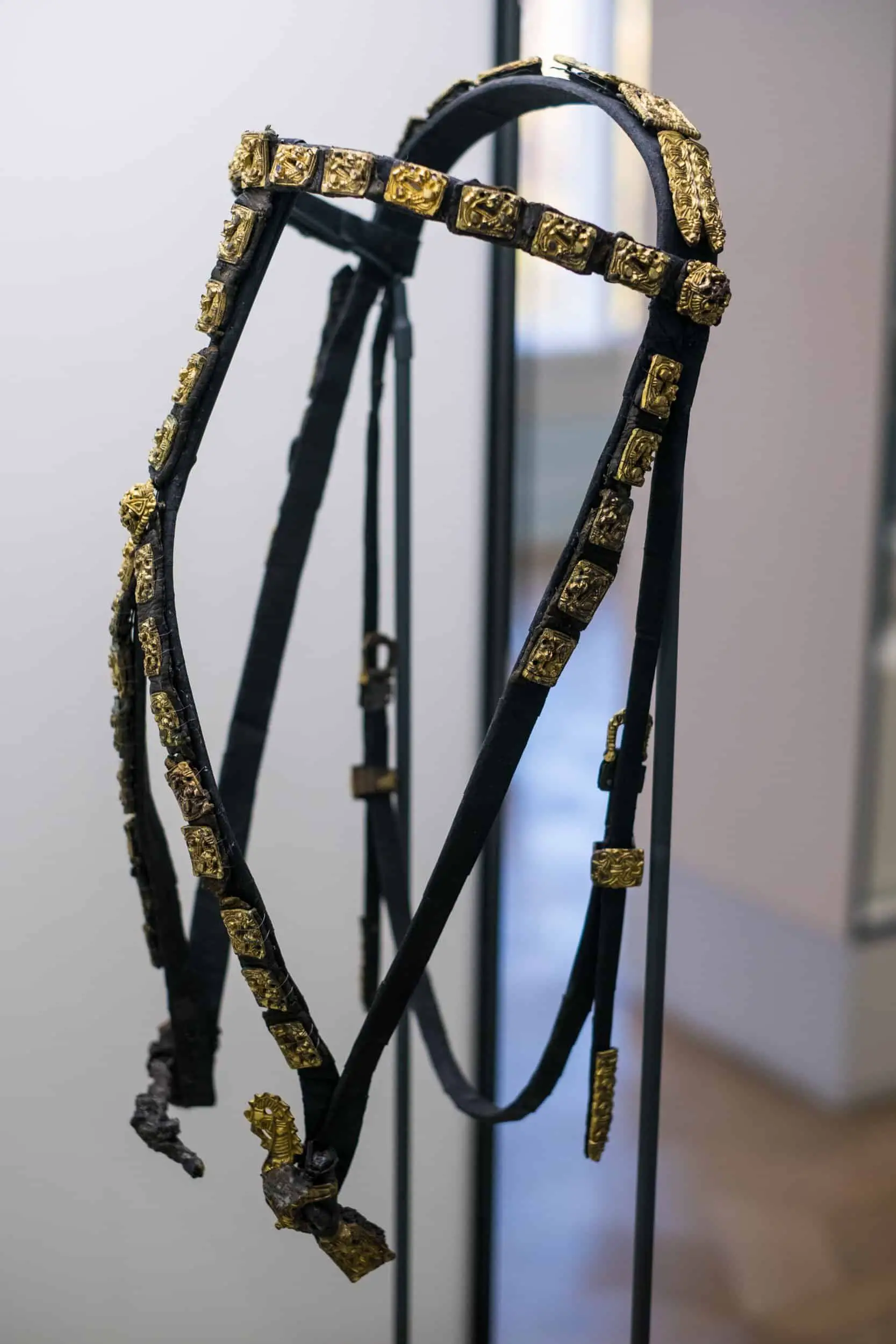
Some road with style in the Viking ages
11. The Sword – Warrior’s Jewellery
Some swords from the Viking Age are especially elaborate. Over 3,000 swords from the Viking Age have been found in Norway, and most were discovered in graves along with other weapons. The swords vary from simple home-forged blades to foreign-made ornated blades with intricate patterns and hilts decorated with precious metal. Swords with the inscriptions VLFBERHT or INGELRII probably came from workshops in southern Germany. The inscriptions could be like trademarks. The Old Norse myths tell of swords made by dwarves and which possessed magical power. The sagas tell of mighty swords passed down from one generation to the next.



12. The Broken Sword
这剑是弯曲的,摧毁了钻前ied as a grave gift. It is not a unique case. Many swords found in Viking Age graves are broken, bent or folded together and show signs of being subjected to hard blows and other violent damage. The destruction was deliberate. Viking burial rituals reflect complex ideas about life, death and the afterlife. Perhaps ‘weapon killing’ was part of a ritual connected to the transition from the world of the living to the world of the dead, where the dangerous power of the sword had to be destroyed?
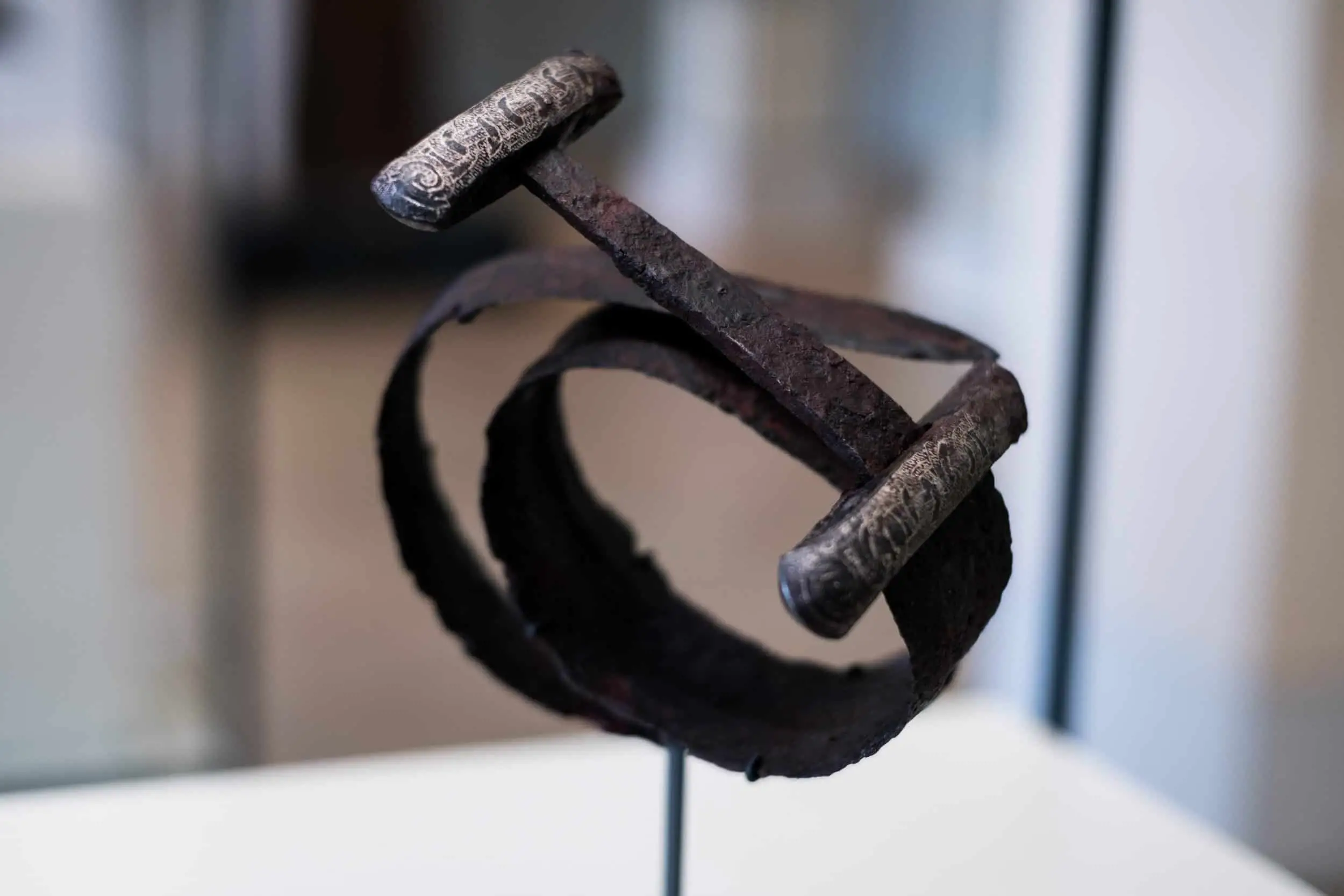
Bent Viking sword
13. Spears for Battle
The spear was one of the warrior’s most important weapons. Spears vary in both form and size. Most spears found in Viking Age graves were used for stabbing, but some slim and light spears may have been thrown. When armies clashed and frontlines stood face-to-face on the battlefield, spears were the weapons of choice. With a length of over two metres, they had a greater range than swords and axes. In Old Norse mythology, spears are associated with the war god Odin. When his spear Gungnir is thrown, it never misses its mark


14. A Female Warrior?
This woman was buried with a sword, spear, battle axe and arrows at Nordre Kjølen Farm in Solør. Her skeleton shows that she was about 155 cm tall and 18 or 19 years old when she died. When archaeologists find graves with weapons, they usually assume that the people buried in the graves are men. But few graves have preserved skeletal material that can reveal a person’s sex, so this assumption is difficult to prove or refute. The woman from Solør could have been a female warrior, but the weapons could also have been symbols of her role in the family or local community.


You might also like:I Visit the Viking Ship Museum in Oslo
Advertisements15. ‘Murdered’ Weapons
The shield bosses shown here were hacked with axes and pierced with spears. They were deliberately ‘killed’ before being burned and buried with the dead. The idea of destroying weapons at a funeral could be compared with sacrificing animals. The Vikings may have understood it as a process of liberation that ensured that the dead and their grave goods entered the afterlife (see also Showcase 12).
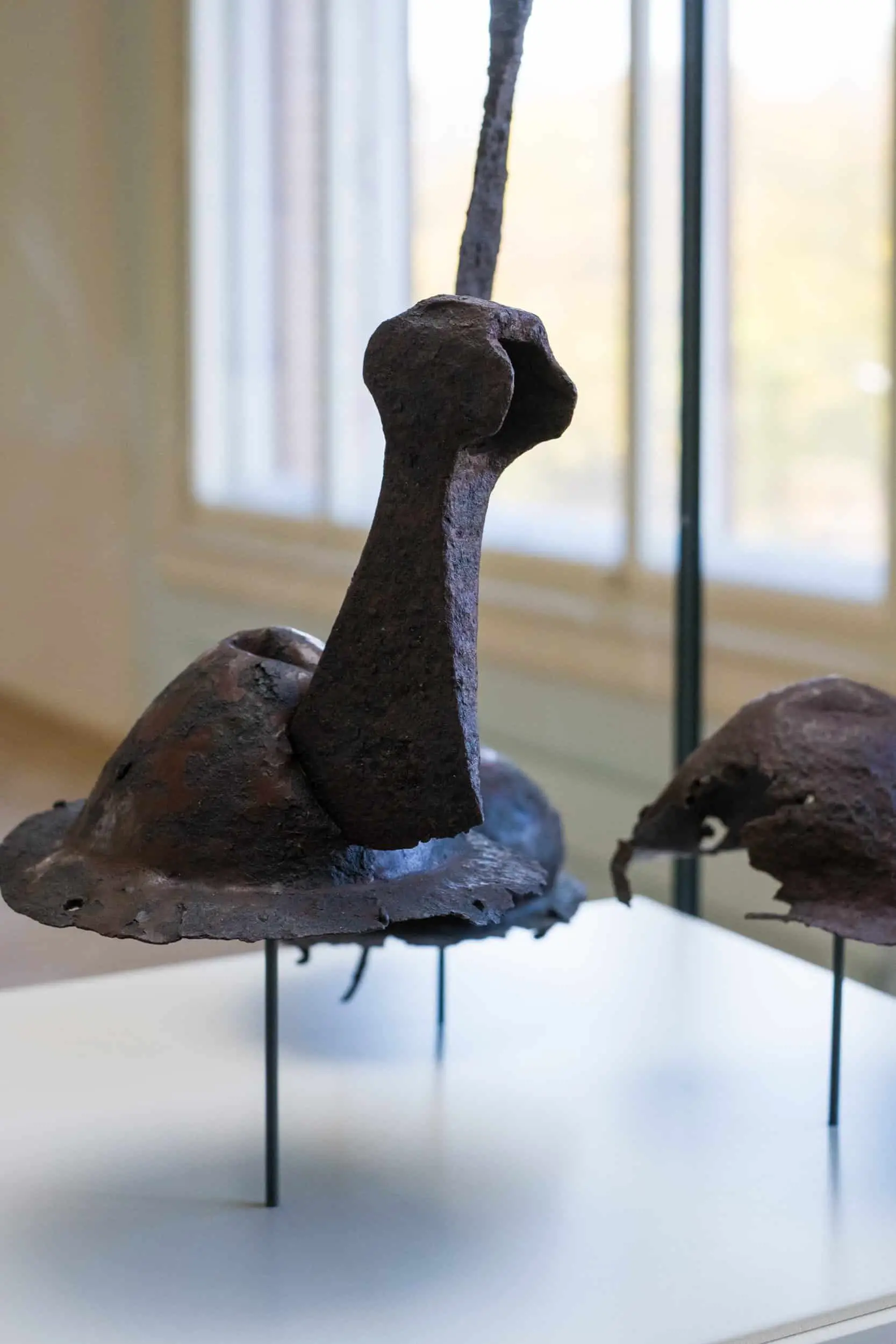
Murdered Viking weapon
(16号没有displayed in the Museum at the moment when I visite)
17. From Ship’s Prow to Church Spire
This weathervane from Heggen Church had an earlier life as a decoration atop a ship. There are only four such weathervanes preserved in Norway. This is the oldest, made in the mid-1000s. The Old Norse sagas tell of golden weathervanes mounted on the prows of warships. When people saw them glinting in the sunlight, they knew a chieftain or a king was approaching. The weathervanes were later removed and placed on medieval churches


18. A Royal Coin Hoard
In 1836 this hoard was found by a farmer under a large stone at Årstad Farm, near Egersund. The stone hid over 1, 900 coins and coin fragments, many from the time when Canute the Great was king of England. In 1028 the Anglo-Danish king paid powerful Norwegian chieftains large amounts of Anglo-Saxon silver coins in return for their support in fighting against King Olav Haraldsson at the battle of Stiklestad in 1030. The Årstad Hoard could be part of this payout.
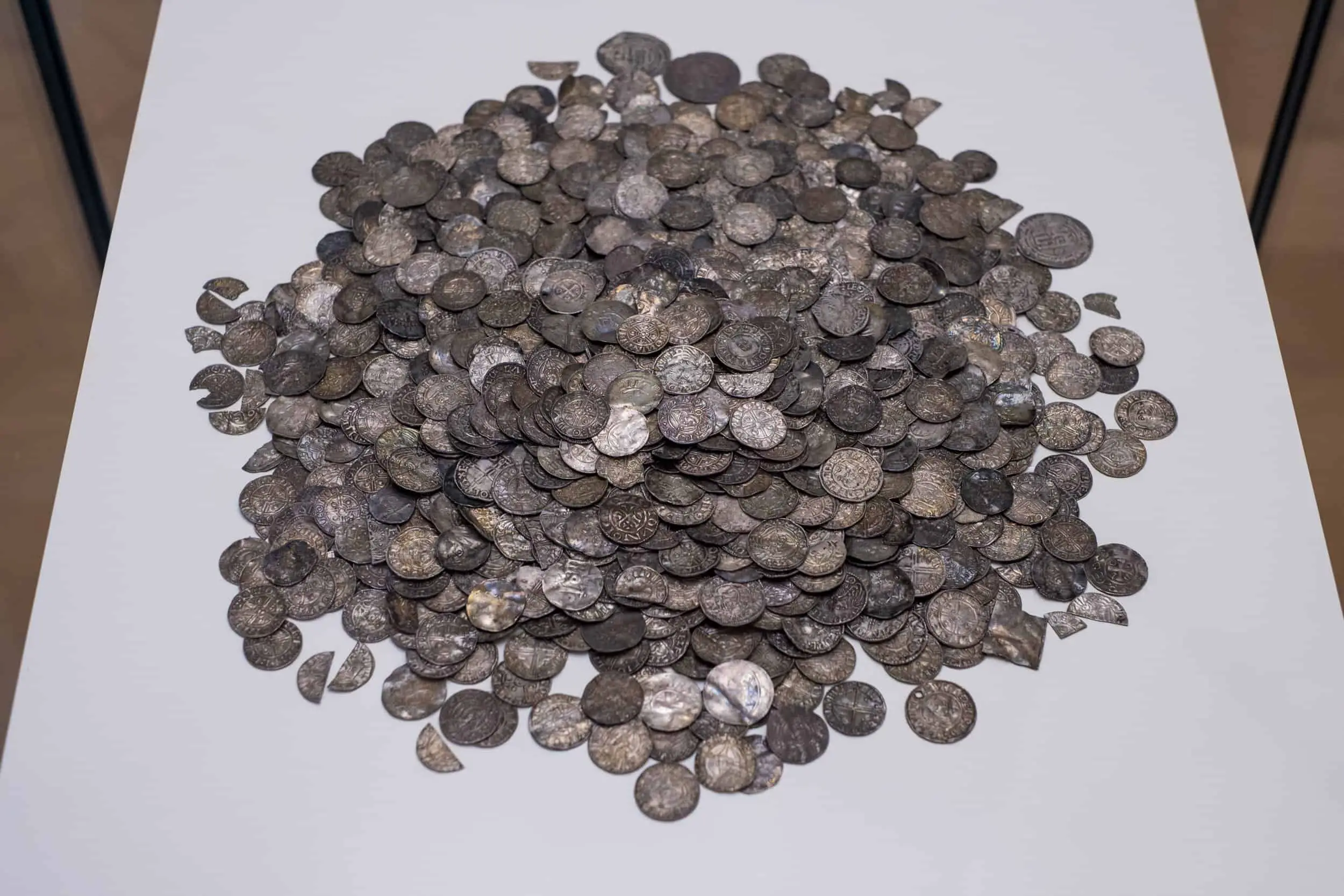
You might also like:I Visit the Viking Ship Museum in Oslo
19. From Thor’s Hammer to Christian Cross
The pieces in this showcase were made between 800 and 1100. They tell of how beliefs changed in the course of the Viking Age. For many people, Thor’s hammer symbolizes the Old Norse religion. The main attribute of the god Thor is his hammer Mjølner, which he uses to maintain order in the world. Pendants with the symbol of the Christian cross have been used in Norway since the late Viking Age. The oldest form, with four equal-length arms tipped with ‘wings’, is often called a Saint Cuthbert’s cross, after the Celtic saint from the 600s.
Advertisements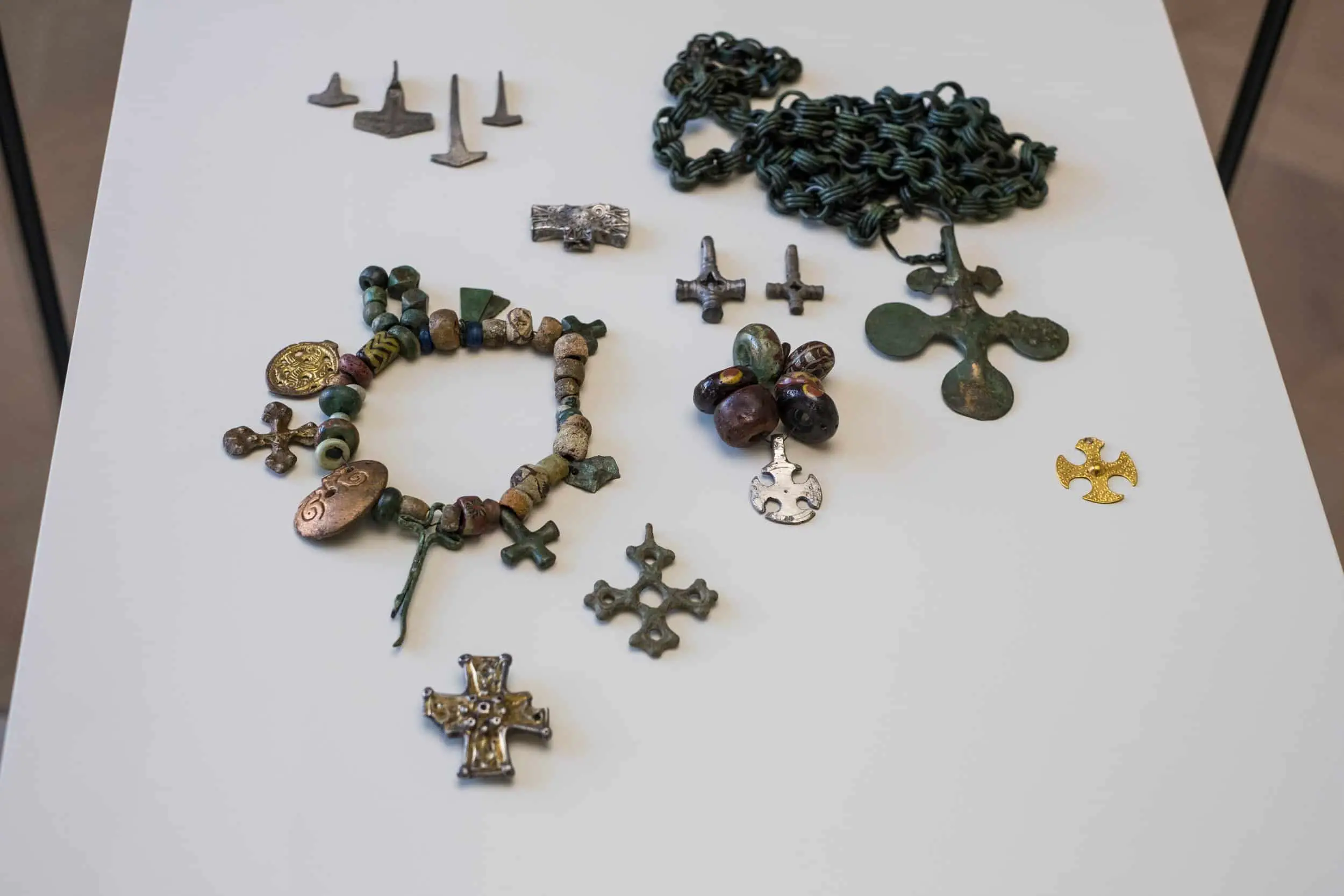
20. Gunnvor Built a Bridge
“Gunnvor, Trydrik’s daughter, made the bridge in memory of her daughter Astrid. She was the handiest maiden in Hadeland.” This is the meaning of the inscription on the runestone from Dyne in Oppland. The stone is from the mid-1000s and testifies to Norway’s transition from paganism to Christianity. The motifs are clearly Christian, but both the style and the practice of raising monumental stones have deep roots in pre-Christian times. The front of the stone is engraved with motifs from the New Testament. We see the three wise men following the star of Bethlehem to the stall where they find Mary and the baby Jesus.



I hope you enjoyed this virtual museum tour! For more about the Vikings read the article I wrote aboutthe Viking Ships in Oslo.
Tusen takk! Thank you!
Pål
Check out thisViking Exhibitionin person at the文化历史博物馆in Oslo.






6 Responses
Thanks for this detailed museum tour with a lot of interesting information!
You welcome Rita! Thanks for checking it out
Takk for turen. Det var deilig å se utstillingen… skal lese litt i Snorre i dag inspirert av de fine Viking bildene dine.
Bare hyggelig, fint at den falt i smak. Alltid interessant å lese Snorre
Thank you for this article with pictures so thoroughly displayed. I appreciate and enjoyed it very much
You welcome, bare hyggelig Thanks for the comment and for checking out the article!